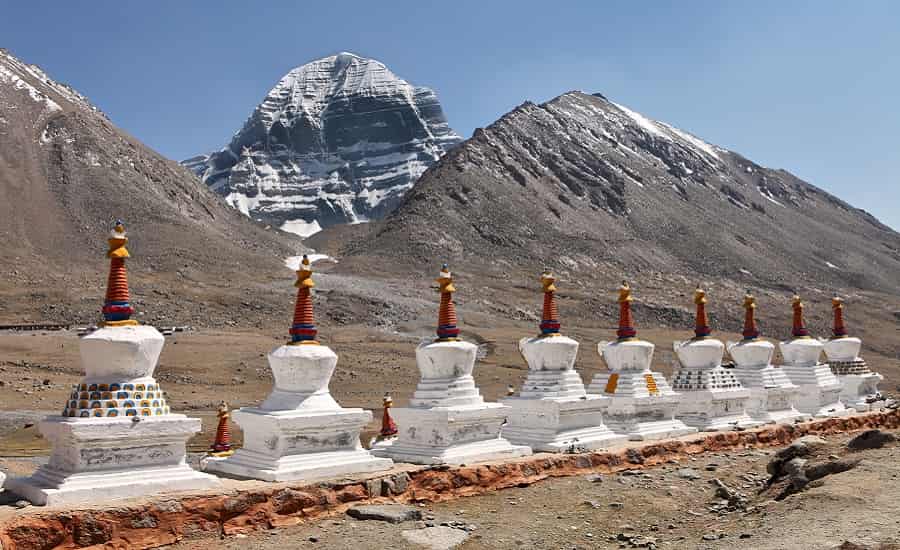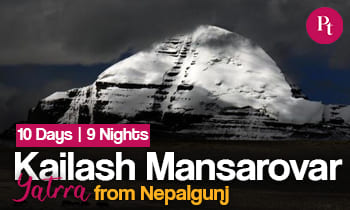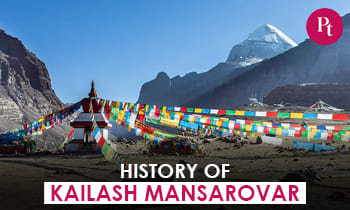Mount Kailash- a mystical mountain in Tibet that is sacred to countless devotees around the world, has a rich history and immense significance. This lofty snowcapped mountain, with the holy Lake Mansarovar on one side and Rakshas Tal on the other, is one that is highly revered by not just Hindus, but also Jains, Buddhists and Bons.
Finding mention in several sacred literature of Hinduism, Mount Kailash is believed to be the heavenly abode of Lord Shiva by Hindus, while for Buddhists, it is the cosmic centre of the universe. For Jains, it is where their first leader found enlightenment, and for Bons, it is where the sky goddess Sipaimen lives.
What is it about Kailash Mansarovar, or Kangri Rinpoche, as Tibetan Buddhists call it, that draws thousands of pilgrims every year? Let us dive into the enchanting and intriguing history of Mount Kailash Mansarovar.

A Brief Introduction to Kailash Mansarovar
The Kailash Parvat is one of the holiest mountains in the world. Situated in the Tibet Autonomous Region of China, it is the the highest peak in the Kailash range of mountains. With an elevation of 6638 metres, Mount Kailash is believed to be as old as 30 million years.
What makes this pilgrimage site so magical is the geography of this region. Situated in a remote area of the cold and dry Tibetan plateau, the mountain overlooking Lake Manasarovar is truly a breathtaking sight. What’s even more enchanting is that four major rivers, Indus, Sutlej, Brahmaputra and Karnali originate from this region.
Manasarovar, the holy lake situated at the foot of Mount Kailash’s southern face, is the highest freshwater lake in the world. At an altitude of around 4580 metres, this pristine lake spreads over a gigantic area of 320 km2.
According to Hindu mythology, the lake was the created out of the imagination of Brahma, which is how it derives its name. Manas, meaning consciousness in Sanskrit, implies that it was born out of Brahma’s consciousness, while Sarovar means lake. Thus, the name, Manas Sarovar.
Not only is this beautiful lake with its crystal clear waters an extraordinary sight to behold, but also a gateway to salvation for the believers of multiple faiths. Pilgrims from all over the world look forward to taking a dip and drinking the water of this lake in an attempt to get rid of their sins.
The Historical Significance of Kailash Mansarovar
The holy site of Mount Kailash and Lake Mansarovar holds immense religious and historical significance, majorly for the believers of four religions, Hinduism, Buddhism, Jainism and Bon. Each have their own unique ways of perceiving the greatness of Kailash Mansarovar and each perspective is just as fascinating.
1- Hinduism
According to Hindu mythology, Mount Kailash is where Lord Shiva resides on earth, with Goddess Parvati and their children, Ganesha and Kartikeya. Shiva is one of the prime deities in Hinduism, widely worshipped as the God of destruction. It is therefore one of the most sacred pilgrimage sites for Hindus.
Kailash Manasarovar is mentioned in much of Hindu literature, like the Ramayana and the Mahabharata. According to legend, Ravana once tried to lift Mount Kailash in an attempt to uproot it. This made Shiva furious, who in turn trapped Ravana under the mountain.
It is also believed that Lord Shiva meditates atop the Kailash Parvat, which is part of the Panch Kailash, and is the most significant of them all, closely followed by Adi Kailash. Undoubtedly, devotees long for a glimpse of Mount Kailash, a circumambulation (Kora) of the mountain, and a dip in the holy Lake Mansarovar.
2- Buddhism
There are many reasons why Kailash Mansarovar is important to Buddhists, especially in Tibet. Tibetan Buddhists know this mountain by the name of Kangri Rinpoche, which means “Precious Snow Mountain”. Several different sub groups within Buddhism consider it holy for varying reasons.
Mount Kailash is considered the Axis Mundi or the cosmic centre of the universe in Buddhism. It is also believed to be the abode of Padmasambhava, who is credited with bringing Buddhism to Tibet.
Known as the mythological Mountain Meru amongst Tibetan Buddhists, Mount Kailash represents the father while Lake Manasarovar represent the mother. Near the lake, there are many Stupas and monasteries that further demonstrate the importance of this site in Buddhism.
3- Jainism
The holy site of Kailash Manasarovar is sacred to Jains as well. They believe that this is where Rishabhadeva, the first of the 24 Tirthankaras attained moksha on a mountain called Ashtapada. Ashtapada- a sanskrit term that means eight steps, represents the path to salvation for Jains.
All in all, Kailash Manasarovar is a truly unique pilgrimage site that has a rich history. It’s not just the fascinating religious tales about it, but also how even today it offers a sense of unparalleled calm to each devotee who reaches this holy site.










 Call
Call WhatsApp
WhatsApp Enquiry
Enquiry